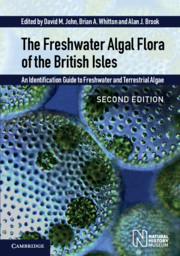 The Freshwater Algal Flora of the British Isles
The Freshwater Algal Flora of the British Isles Published online by Cambridge University Press: 12 January 2024
The Xanthophyta are much less species-diverse than the Chlorophyta, with about 600 species and many of the 100 known genera containing only a few species. However, they show a wide range of form and include biflagellate and non-motile unicells, simple or branched uniseriate filaments, and others are coenocytic or siphonous (large multinucleate cells). Colonial forms may or may not have a well-defined shape. Some species are epiphytes and sessile or attached by a stalk.
Most are non-motile, single-celled or colonial, although there a few more advanced filamentous forms and coenocytic forms such as Vaucheria. If motile, they are biflagellate, and often possess associated photoreceptors. Asexual reproduction is mainly by fragmentation into portions of one or more cells in multicellular species, aplanospores or zoospores that each have two unequal flagella and sometimes an eyespot. Sexual reproduction is apparently comparatively rare, although well-known in Vaucheria, where it is distinctive and provides important taxonomic characters. Resting structures or cysts are known and often have walls impregnated with silica. Heterogamy is uncommon and isogametes known only for a few genera.
The distinction between the Xanthophyta and the Chlorophyta rests largely on chloroplast pigments and food storage products rather than on morphological characters. Traditionally, there are three features that distinguish the xanthophytes: (i) yellow or yellowgreen colour of the chloroplasts; (ii) carbohydrate storage as oil droplets or chrysolaminarin (usually termed leucosin) granules, with starch and pyrenoids rare; (iii) walls of pectin or pectic acid (sometimes in association with cellulose or siliceous substances) and consisting of two spliced and overlapping sections (most conspicuous in Tribonema), which on dissociation of the filaments tend to break into H-shaped sections or pieces. Although a useful taxonomic character, these sections are not present in all genera, and certainly not always readily visible even in genera where they occur.
In practice, the yellow-green colour of these plants is not always easy to distinguish, and in the case of Vaucheria, the colour is indistinguishable from that of green algae (Vaucheria was initially described as a green alga). The xanthophytes differ in containing no chlorophyll b, but in addition to chlorophyll a have chlorophylls c1 and c2; other pigments are carotenoids (especially b-carotene) and at least three xanthophylls. These xanthophylls can give these algae a blue-green colour when treated with hot hydrochloric acid in the laboratory.
To save this book to your Kindle, first ensure no-reply@cambridge.org is added to your Approved Personal Document E-mail List under your Personal Document Settings on the Manage Your Content and Devices page of your Amazon account. Then enter the ‘name’ part of your Kindle email address below. Find out more about saving to your Kindle.
Note you can select to save to either the @free.kindle.com or @kindle.com variations. ‘@free.kindle.com’ emails are free but can only be saved to your device when it is connected to wi-fi. ‘@kindle.com’ emails can be delivered even when you are not connected to wi-fi, but note that service fees apply.
Find out more about the Kindle Personal Document Service.
To save content items to your account, please confirm that you agree to abide by our usage policies. If this is the first time you use this feature, you will be asked to authorise Cambridge Core to connect with your account. Find out more about saving content to Dropbox.
To save content items to your account, please confirm that you agree to abide by our usage policies. If this is the first time you use this feature, you will be asked to authorise Cambridge Core to connect with your account. Find out more about saving content to Google Drive.